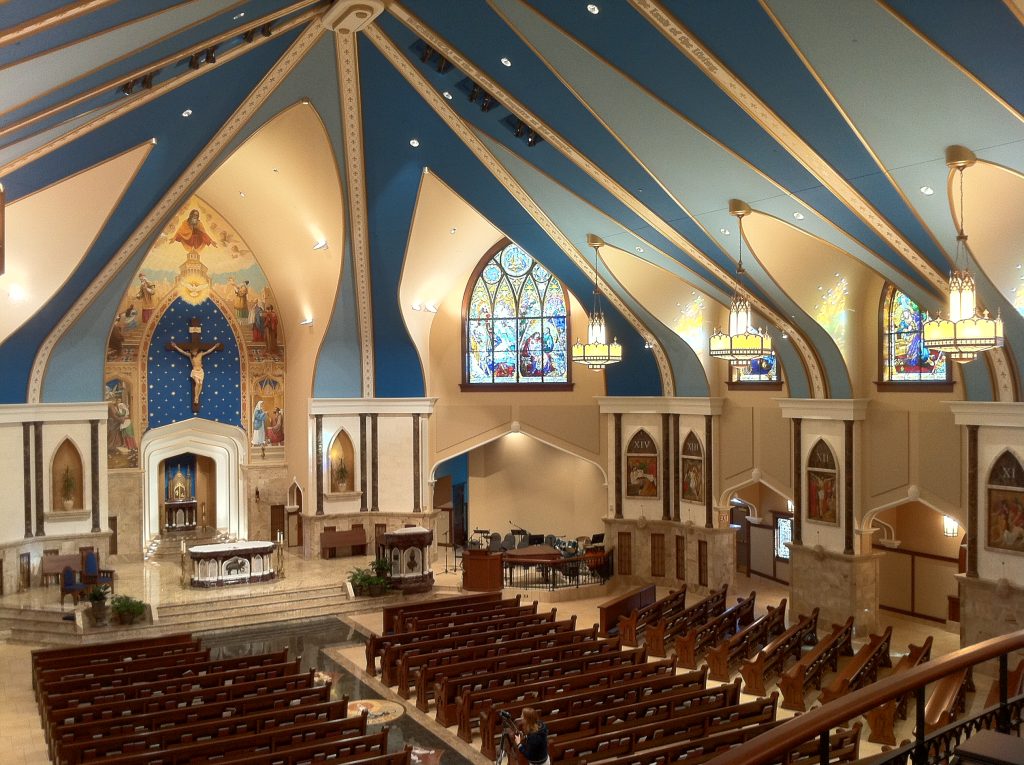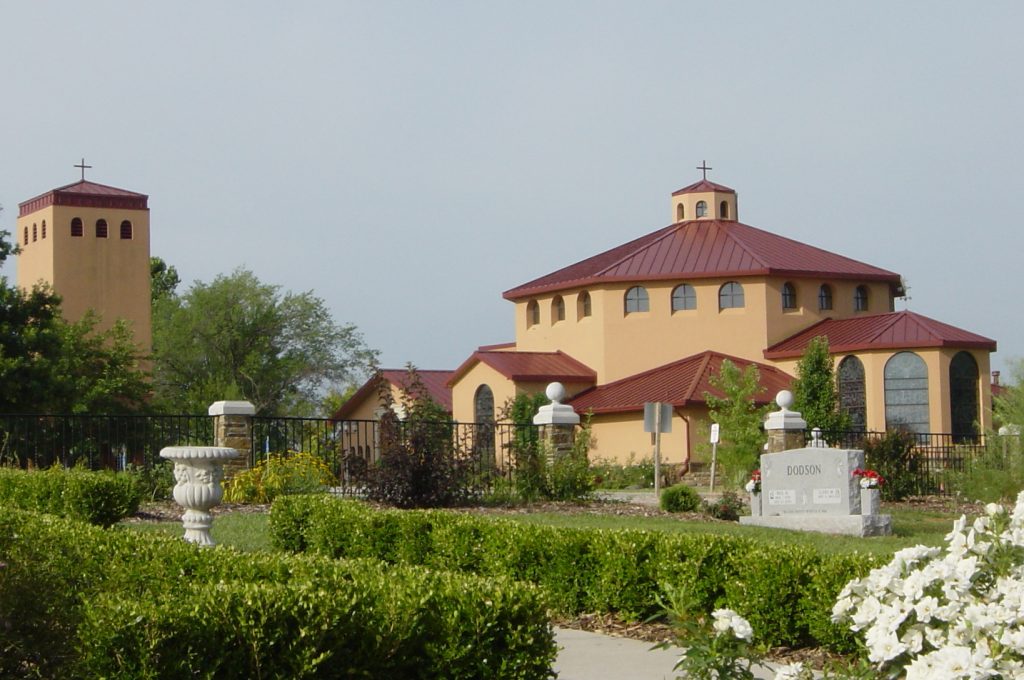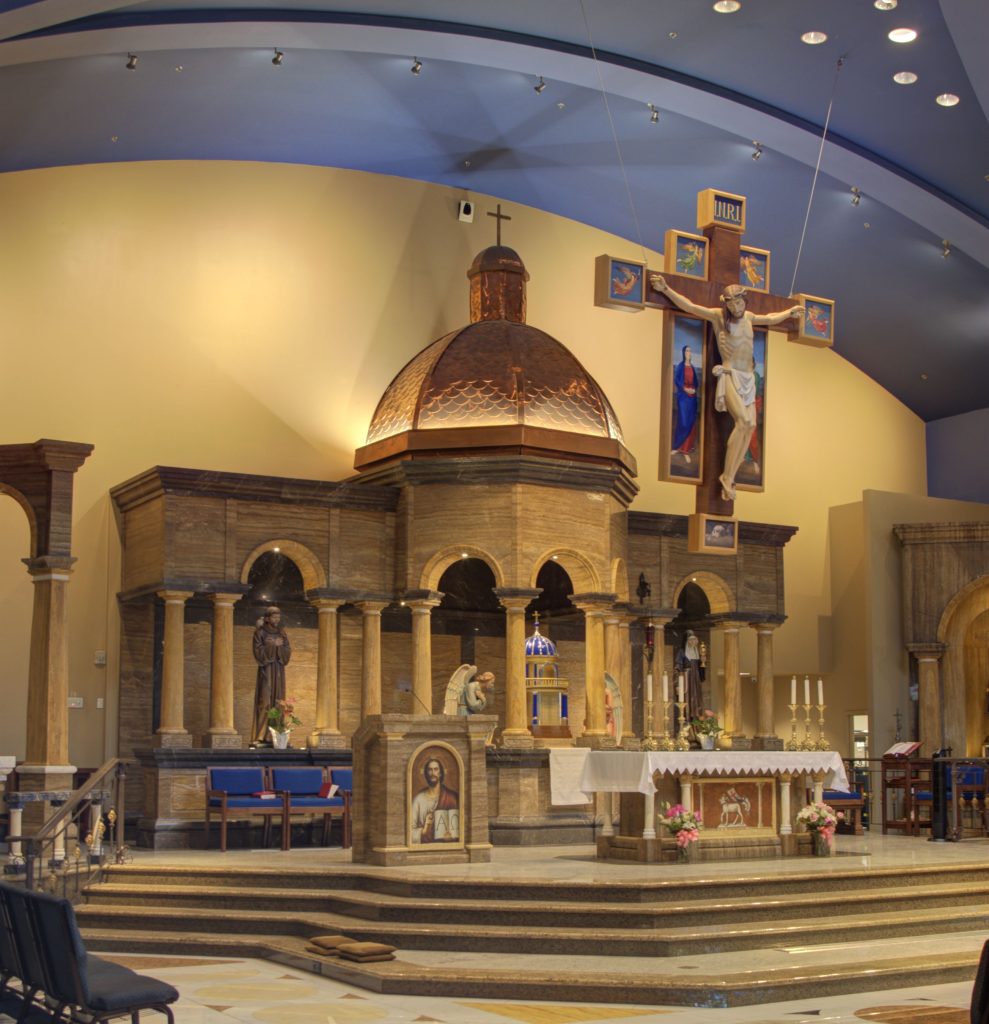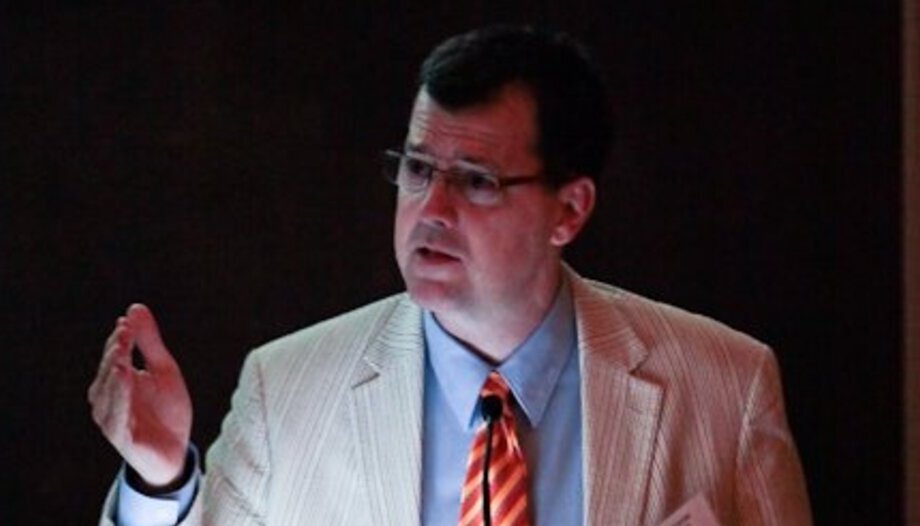Architect and theologian, Steven Schloeder seeks to respond to contemporary challenges in building Catholic churches by drawing on the symbolism that has accompanied them throughout history. In his book Architecture in Communion (Ignatius Press), not yet translated into English, speaks of three main symbols in the language of architecture: the body, the temple and the city.
How does the architecture symbolize and represent the importance of what is being celebrated?
-Primarily, we build churches for the celebration of the liturgy, which is necessarily a communal event of believers in Christ gathered together. The liturgy manifests the Body of Christ. The Church is the Body of Christ, and the continuation of the Body of Christ on Earth. It is a physical and spiritual, eternal and temporal, heavenly and earthly reality.
God reveals himself through symbols, and Christ has revealed to us the meaning of specific symbols: the symbol of the body, the blood, of his crucifixion. They are sacramental, effective symbols, the true reality in which we participate. The liturgy is both material and spiritual, communal and hierarchical.
When we approach a church from the outside, on the street, it helps if it looks like a church. Not all contemporary churches look like churches, and that is a problem that needs to be addressed. When we approach a church, we approach the heavenly Jerusalem, the City of God, the Body of Christ, the Temple of the Holy Spirit, and I think the local parish or cathedral should be thought of as the presence of the heavenly Jerusalem in our city. It is an interruption in the fabric of the city, the place where something sacred is happening. In Revelation there is this image of the heavenly Jerusalem descending, God living among men, and that is what we should really see when we see a church and what we architects should express in some way.

Once we are inside the Church and approach the altar, the language of the altar helps us to understand that we are entering a sacred event and a sacred place. Very significant is the crucifix as the central icon of the liturgy, as Cardinal Ratzinger said.
This is not just a meal, it's not just a table, it's not just a gathering of people, but of the people on Earth and that of the heavenly Jerusalem, the Church triumphant. I think the formality of the language of architecture and things like symmetry, height or quality materials are fundamental, because we are trying to express something that is tremendously important. We express importance and dignity through the value and the way we treat things in our material culture.
An altar, for example, is not just a wooden board, like a table for eating. Using good vestments, valuable liturgical objects, such as the chalice or ciborium, good linen and good quality stone helps us to understand the importance of what is being said. Then, of course, there are the liturgical texts themselves, the prayers of the priest and the responses. That is what conveys the intention of the church: to offer this perfect sacrifice at Mass.
That's why there's liturgical discipline: fasting before receiving Communion, being in a state of grace before receiving Communion, dressing appropriately, having a sense of real dignity in terms of the material setting of the church. I think that's one of the important things about previous generations of architecture, that the church was very deliberate and intentional in their material culture and architectural.
It showed that it was something of great importance and deserved our full attention.
How have churches evolved over time? What have been the most important turning points?
-We know that at the beginning the communities met in houses. Very soon, in the middle of the second century, there began to be vestiges of consecrated churches. We have no archaeological evidence of this, because they have been lost. The earliest surviving churches date from about a century later, but we have evidence through written documents that there were churches about a hundred years earlier, visible buildings that could be identified as places of worship. Christians had settled in communities that could own land and build. This occurs very early in the history of Christianity. Before Constantine, during the persecutions in the late 3rd-early 4th century, Lactantius, for example, the historian, talks about large buildings being destroyed as part of the persecution. So the Church was having a strong identity when it came to leaving its mark on the city or town.

Eusebius has a fantastic passage in his History about the dedication of the cathedral of Tyre that speaks about the symbolism, the beauty and the importance of the building. I think Eusebius is not inventing this language of ecclesial architecture, but there was already a well-established knowledge of what a church should be, because he writes at the beginning of the fourth century and he has a fully formed theology of architecture that I don't think came to him all of a sudden, but he is expressing what the Church had already cultivated. So there were already monumental buildings that were important and identifiable.
Perhaps under Constantine, who is the head of Eusebius, the Church probably adopted a formality imitating the royal court, considering it suitable for the King of Kings, the Lord of Lords. At that time the basilica plan was adopted, the traditional form of the church, which appeared in the third century and probably somewhat earlier. From this point on, there were a series of stylistic innovations: Byzantine architecture, Romanesque, Gothic...
The point is that each of these styles follows a pattern. We find a communality in the formal language of architecture. First of all there is a language related to the body: symmetrical and hierarchical (we have head, chest, legs...). And this is something precious that I think we have to recover both in architecture and in art: to reencounter our body in a sacramental sense.
In a church in the form of a cross, the head is the apse, where the bishop's seat is, because it represents Christ ruling the Church, the transept is the chest, where the altar is, the heart; from there the arms come out, and the feet are the entrance, because you enter walking into the Church. There is a symbolic way of thinking related to the body.
I also believe this refers to the Incarnation and defends it as the "logos," which is communicative, formative and creates reality. The Incarnation of Christ in a human body is always our model for understanding who we are as persons and as Church. We immediately recall St. Paul (1 Cor. 12:12).
There is also language related to the temple, to the Tent of Meeting and Solomon's temple. Christ himself speaks of his body as "the temple". He himself establishes these relationships. St. Paul develops this, and Eusebius also speaks of it. We always think of form symbolically. With architecture, we seek to express a deeper truth.
In Revelation 21-22, we see that the tabernacle is then transformed into the City. If we look at a Gothic church, it is brilliant the way it is represented: every part of the building, the ciborium or the baldachin over the altar, is a small building. The buttresses outside the building are little shrines and all the shrines are little houses that make up a city. The aisles and corridors are like roadways. There are direct analogies that help us understand this interconnection between the body, the temple and the city.
Throughout the centuries, regardless of the style of the church, this is the main language, which somehow refers to the fact that we are body and we live in buildings, houses, which is the family house, the domestic church. This is fundamental to the importance of the family as the central nucleus of society. And it also underlies the concept that we are social beings and we have to live in community in order to grow. The church as a building and the theology of architecture should somehow represent all of this. They are concepts faithful to the way God has revealed himself to us: the Body of Christ and the Church as temple, as the heavenly city.
Then we come to the twentieth century, which is a radical break. Especially, it arises in Germany, through the work of Rudolf Schwarz, for example, and the Bauhaus. Many other people who were not part of the Bauhaus were doing similar things, but we talk about modernist architecture in general.
The churches cease to be hierarchical, and begin to have circular forms. German Lutherans and Catholics begin to play with other more centralized forms. And at that point I think we have lost the unity of the church as a symbolic presentation of the heavenly reality. Not that it's completely divorced from the earlier, but the centralized form, which generally has some sort of swooping, tent-like form, is a decisive break in the continuity that was there 1900 years earlier. It becomes the main form of sacred architecture in Europe and America, especially after World War II and the rise of modernism. Many of the cities of Europe that had been bombed were rebuilt with modernist forms.
What has been the evolution of the baptistery and its symbolism?
-The main thing about baptism is that it is one of the sacraments of initiation, which introduces us into the Body of Christ. In the earlier rite, before the revisions of the sixties, there was very interesting language related to moving from the region of darkness into the realm of life. There was a series of prayers as the person first entered the church, because you were being ushered into the Kingdom. The baptistery back then was fenced in, with a fence around it or some kind of protective contraption, because there was a sense of being brought back to primal innocence and righteousness, and the gates of Paradise were being opened for us. Baptism is an entrance into the Church, into the Kingdom of God, coming out of darkness and chaos, and light becomes a very important element.
Now usually the baptistery is placed at the entrance of the church, which is not wrong, it is in fact an entrance to the church, but it is often placed in line with the altar, at least in the United States. Because in the United States in the fifties a German liturgist published a book in which he said that the most important thing was the altar and then the baptistery, and everybody gathers around both of them. So they line up and everybody has to dodge the baptistery, you can't have a straight procession. This became a stylistic motif.
The symbol that has been lost is that the baptistery is also a place of death, where we die to our sins and become a new man. The baptistery is the womb in which Christians are born, but also the tomb where we die and are born in Christ. It is possible that the old models are no longer in force: if we look at some of the famous baptisteries, such as those of Pisa, Florence or Ravenna, they are usually octagonal in shape, based on the Roman mausoleum. But we have to recover a way to express the different meanings of the baptistery: water, life, death, being incorporated into the Body of Christ. We architects play with a language rich in symbolism with which we try to convey and support what the Church is trying to teach us, and the baptistery is a microcosm in this sense.
In architecture, I believe that in the last twenty years we have been working to recover the sacramental dimension of the building.
What about the confessional?
-What we know about confession is that in the old days, when murderers were on their way to execution, they would cry out: "I have sinned, pray for me". We have some documents of that. Then in the early church you could confess once in a lifetime, so it was usually done towards the end of life. You had to stand on the steps of the church and confess your sins to the bishop. And everybody knew about it. So I think it's been reasonable to develop private confession from a more pastoral perspective, which was especially developed through the monks in Ireland.
Today, I have seen confessionals that have glass booths, like an office space, with a table for the penitent and the confessor. It is very transactional. I think we have to recover the sense of confession as a sacrament that deserves its own space, like the baroque confessional, where you have the priest in the center and space for the penitents on either side. It becomes an object in the space, in the place of the sacrament.
During the last twenty years there has been a revision of the importance of private, discreet and anonymous confession, both for the priest and the penitent. It is an encounter with Christ, through the minister and the words of Christ's priest. We are in an interesting time in the development of sacred architecture, where we have the priest face to face and become familiar with him, and the same is true in confession.
As a theologian and architect, what I seek is to flesh out the language of architectural arrangement and form, so that it supports what the Church does sacramentally.
What characteristics do the elements of the sanctuary have to have and what should be taken into account when building them?
-The altar is central and prevalent, and the ambo is the place of proclamation. In the time of St. John Paul II the concept of "the two tables" was developed: the table of sacrifice and the table of the Word. I think it is important to establish a relationship between the Word proclaimed and the Word as bread (Mt 4:4). They are two elements that should be architecturally related.

Then we also have the place of the Eucharistic reservation, the tabernacle. I do not know what the situation is in Spain, but a few years ago there was a great movement in the United States that sought to separate the tabernacle into a separate chapel. It was, in a way, imposed by the liturgists. Nowadays, the tendency is to reestablish the tabernacle in the temple, and I think rightly so. Because one of the arguments was that since the priest is now facing the assembly, he is turning his back on the tabernacle.
But the language of the tabernacle already solves that. It is the Tent of Meeting. What's appropriate is that it's opaque and solid, and covered, so it's its own room, its own sacred space, when it's properly constructed. It's the same language of "concealing" or "veiling" that's in the Tent of Meeting or in Solomon's temple. When the doors are closed, life can go on. When they are open, we see the Lord in his glory, in the shechinah. This enables us to live our lives in the presence of God. For, if we see God face to face, what can we do but fall on our knees in worship?
I believe that the point we are at now, returning the tabernacle to its original place, works, because, when we enter a church, we kneel before the Lord who is in the tabernacle, we do not need to look around to find him.
As for the see, Church documents point out that it emphasizes the presence of the minister as Christ presiding among his people. The priest is representing the bishop. It is a place of dignity, a place of presidereThe church does not tell us much about it. The Church does not tell us much about it. In some of the older documents, it talks about the seat being placed at the apex, the highest point of the sanctuary, but it shouldn't look like a throne. But if you look at any royal throne, it is always in the highest place, in the center. So there are mixed messages in the language of the seat. It is a place of service, a place to preside, but it should not be a throne or a cathedra.
Then there is the crucifix itself. In the words of Cardinal Ratzinger, it is the central icon of the liturgy, because everything has to do with the wood of the Cross and the crucifixion of Christ and his death on the Cross. So where is the best place to put it? What does it represent? We are not praying to the Cross, nor are we praying to Christ, we are participating with Christ in his offering to the Father, and that is the theology of the crucifix, that is the central message of the Mass in its sacramental, priestly and sacrificial sense.
Christ the High Priest offering Himself on the Cross. At The feast of faithRatzinger said that the crucifix becomes an open iconostasis to which both the priest and the assembly look. It is in the middle, above the altar, and I think it is a precious and reasonable place, it becomes a point of reference shared by the whole church in prayer, the ministerial priest and the royal priesthood, of baptism, offering our lives united with the minister in one priest.
That is the dynamic of the liturgy, which the crucifix should support. It has the importance of developing the theology of the laity as members of the baptismal priesthood. And that was a very clear message in the documents of the Second Vatican Council, that there really is a sacrifice that we as laity are called to offer, and it is the sacrifice of St. Paul's letter to the Romans: present yourselves as "a living sacrifice, holy, acceptable to God" (Rom 12:1). So I believe we are called to take our whole life and bring it to the altar. As we present the offerings of bread and wine, we are presenting our hearts for Christ to heal and we are also offering our own lives.








